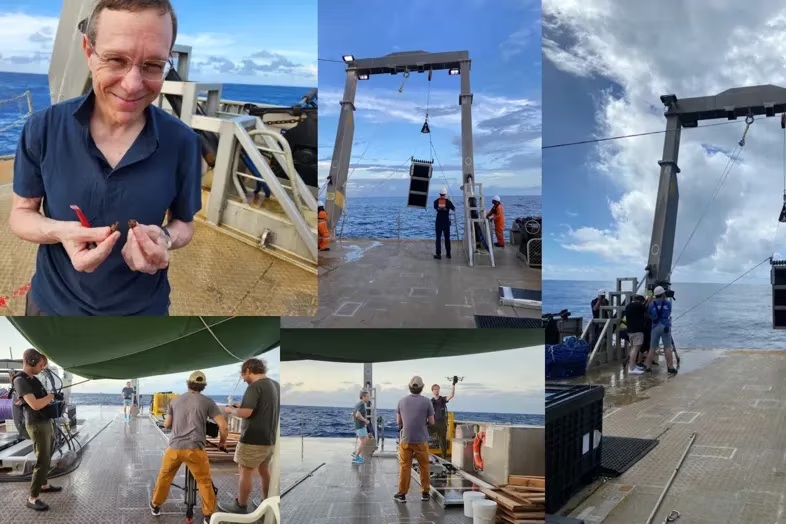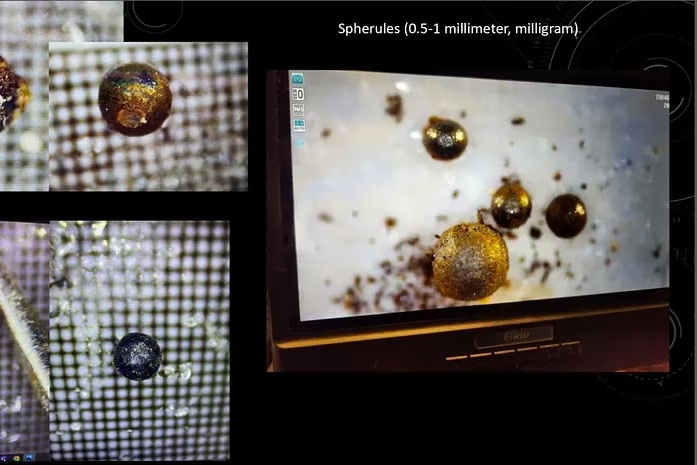Scientists from Harvard University have collected fragments believed to belong to a huge interstellar meteor, saying it could have come from an alien spacecraft.
Avi Loeb led an expedition to find the remains of a 500-kilogramme interstellar fireball that crashed in the ocean near Manus Island, in Papua New Guinea, in 2014.
The team set out on a research boat called Silver Star in late June.
Using a magnetic sled, they excavated debris from the ocean floor where the meteor hit.
“Most of the material was volcanic ash, black powder,” Professor Loeb told the ABC.
It wasn’t until they used a fine mesh sieve to filter the volcanic ash that they found what they were looking for — tiny metallic balls referred to as spherules.
“That was a thrilling moment. I hugged the people around me when we found it,” he said.
The spherules are like marbles, made mostly of iron, each a fraction of a millimetre in size.
If they are proven to be from outside our solar system, Professor Loeb says it will have been the first time humans have collected and studied interstellar material.
Professor Loeb sent about 50 of the spherules, weighing just 35 milligrams, back to the United States by post.
“Even though it took a few days to deliver them to my home, it probably took millions or billions of years for them to arrive to Earth in the first place,” he said.
Three laboratories are now working on analysing the objects.
“We hope to figure out whether the elements that this meteor was made of are, indeed, different from solar system materials,” Professor Loeb said.
“The second question is, can we tell whether the object was technological in origin.”
Professor Loeb said it might be the first sign of civilisation beyond our solar system.
This meteor was moving at a speed of 60 kilometres per second outside the solar system — faster than 95 per cent of all stars. So that suggests potentially that it could be a spacecraft from another civilisation,” he told ABC.
Speaking to the ABC in April, Swinburne University’s Sara Webb — an Australian astrophysicist who is not involved in the project — said while the discovery was “like a scientific gold mine” reports of “alien objects” could give rise to disinformation.
She while it was “incredibly interesting”, it could simply just “be a piece of rock”.
While the discovery has sparked excitement around the world, PNG officials have raised concerns about the research.
The ABC can reveal the expedition team entered PNG on business visas and did not have a permit or official approval to conduct the research.
Wilson Thompson, chairman of the PNG National Research Institute (NRI), said his department did not receive a research application from Harvard.
On its website, the NRI is listed as the only authority able to issue research visas in PNG.
“We would have expected them to have gone through the established process,” Thompson said.
“If they were coming in for research purposes, they would have applied for a research visa.”
Expedition coordinator Rob McCallum said his team had been communicating with the PNG government for eight months leading up to the trip.
“We were advised that the best course of action was to supply a marine science research permit application because we’re operating in the marine environment,” McCallum said.
The PNG Department of Justice and Attorney-General introduced marine research guidelines in 2021, with the aim of improving regulation.
McCallum said complexities arose from the unique nature of the study.
“This is the first time anybody has researched an object from interstellar space,” he told ABC.

The team lodged multiple applications, none of which were approved.
“So it hasn’t fitted into any of the traditional research mechanisms that people typically follow for a biological or geological science programme.”
When asked why the team did not wait for the bureaucratic issues to be resolved, McCallum said: “I’m not sure how to answer that.”
Authorities on Manus Island have also complained they were not notified of the research.
Acting deputy administrator Penua Polon said the team should have contacted his office, even though the expedition area was technically outside Manus waters.
“Protocol stipulates that for any visitors [conducting business or research] into the province, you must … do a courtesy call to the provincial government and the provincial administration so that we are aware of your presence,” he said.
“The protocol still applies because the last port of dispatch was Manus.”
But Polon acknowledged complexities within the system.
“You see, we have a number of agencies performing the role of administrating scientific research [in Papua New Guinea],” he said.
“Poor guys, they need to go to quite a number of them. So I understand why they skipped some of those national agencies.”
The Harvard research team has established a research partnership with the PNG University of Technology.
A letter from the university’s vice-chancellor, Ora Renagi, pledges “full support” for the expedition, saying:
“The outcomes are most likely to provide the most significant astronomical discoveries ever made.”
Professor Loeb said a department chair from the PNG University of Technology would travel to Harvard University soon to take part in the analysis.
Professor Loeb and his team hope to return to the meteor site to collect more material.
“Now we know where to look because these spherules are just like romantic rose petals that lead you to your partner,” he said.
“The partner is any big piece of this meteor that may lie on the ocean floor. And we hope to look for it in a future expedition.”
The meteor – referred to as CNEOS 20140108 or IM1 – was detected by U.S ballistic missile systems in 2014.
Last year, the U.S Space Command confirmed it to be an interstellar object, meaning it had come from outside our galaxy.
Professor Loeb said material from the meteor could be dated using radioactive isotopes.
“We plan to share these materials with anyone within the worldwide scientific community. So there is no commercial value whatsoever,” Professor Loeb said.
McCallum said the expedition should be seen as a success.
“This project is of huge scientific value,” he said.
“This is going to potentially change our understanding of the universe around us. And I’m just so delighted that Papua New Guinea got a front seat at the table,” he said.
SOURCE: ABC PACIFIC/PACNEWS














